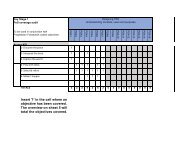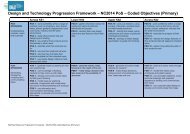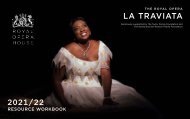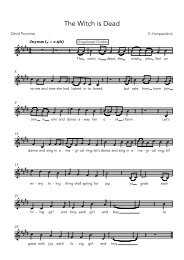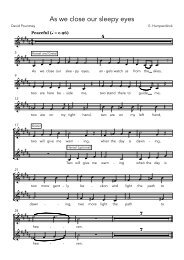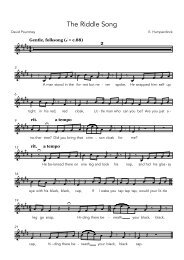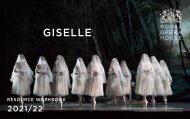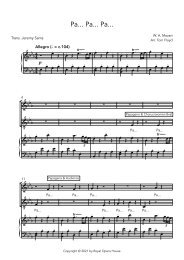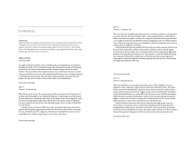Trailblazer Evaluation Report 17/18
Create successful ePaper yourself
Turn your PDF publications into a flip-book with our unique Google optimized e-Paper software.
THURROCK<br />
TRAILBLAZER<br />
20<strong>17</strong>/<strong>18</strong><br />
CULTURE<br />
FOR<br />
GROWTH
“Year on year we have improved the<br />
opportunities and experiences for<br />
students in our school and this has<br />
largely been influenced by the<br />
<strong>Trailblazer</strong> programme...<br />
...As we grow as a school, <strong>Trailblazer</strong><br />
will also. Every year it is getting<br />
stronger and stronger”<br />
Cultural Champion
Contents<br />
<strong>Evaluation</strong> Aims 1<br />
Thurrock <strong>Trailblazer</strong> - How it has progressed during 20<strong>17</strong>/<strong>18</strong>? 2<br />
What has been achieved this year? 2<br />
Satisfaction with the programme 5<br />
Outcomes for schools 7<br />
Developments 8<br />
Collaboration and leadership 8<br />
Leading a Change Culture 9<br />
A network for good practice 9<br />
Making change at school level 11<br />
Investing in leadership 19<br />
Moving to a Culture of Growth 22<br />
Inter-school partnerships and collaboration 22<br />
The influence of Multi Academy Trusts (MATs) 24<br />
Engagement patterns 26<br />
Engagement through the MATs 28<br />
Conclusion 30<br />
Recommendations 32<br />
Appendices 34
Photo Credit: Belinda Lawley<br />
‘‘<br />
I was completely inspired by what happened...<br />
children suddenly had access to palaces, live<br />
theatre, opera, ballet, museums, dance, drama<br />
classes and so much more. The opportunities<br />
on offer gave meaning, context and purpose<br />
to all children’s cultural learning<br />
’’<br />
CULTURAL CHAMPION
<strong>Evaluation</strong> Aims<br />
To report on the transformative journey that is the overarching aim of Thurrock<br />
<strong>Trailblazer</strong>, and to comment on the effectiveness of support and development of<br />
cultural leadership in Thurrock schools.<br />
This report considers:<br />
• The shift amongst the Cultural Champions from advocacy to influence to impact<br />
• Progress towards a school led community of reflective practice for cultural<br />
learning<br />
• The impact of a growing number of collaborative relationships<br />
• Patterns of engagement and implications for the programme mid to long term<br />
Evidence has been gathered through:<br />
• Observation and documentation of training and development sessions<br />
• Interviews with teachers and senior leaders<br />
• Programme data collection<br />
• Survey returns from Cultural Champions and cultural partners<br />
• Feedback collected during knowledge exchange activity<br />
• Enquiry based, teacher led reflective practice reports<br />
1
Thurrock <strong>Trailblazer</strong> -<br />
How has it progressed during 20<strong>17</strong>/<strong>18</strong>?<br />
Thurrock <strong>Trailblazer</strong> is an innovative programme of high quality arts and cultural<br />
activities, visits to heritage sites and specialist teacher training, that boosts creative<br />
learning in schools and accelerates pupils’ development.<br />
In partnership with Thurrock Council, the Royal Opera House (ROH) is working<br />
with local, regional and national arts organizations to deliver cultural education in<br />
Thurrock. It began in 2014/15 and now enters a fifth year of delivery.<br />
What has been achieved this year?<br />
• Emphasis on the ROH National Programme 1 has been well received<br />
• A successful pilot for ROH Design Challenge at KS2 and roll out into Secondary<br />
• <strong>Trailblazer</strong> Moments culmination events had wide reach<br />
• Increased numbers of pupils and teachers have engaged this year<br />
• High satisfaction levels for all aspects of the programme<br />
• Improved standards and progression in schools’ arts curriculum<br />
• Deeper impact seen across the wider curriculum and whole school<br />
• Continued sharing of good practice and inter school collaboration<br />
• New design and layout of cultural catalogue well received<br />
• Successful Recruitment for 20<strong>18</strong>-19, with school numbers increased<br />
• Schools that have not engaged before are registered for the coming year<br />
• Every Thurrock secondary school has now signed up for 20<strong>18</strong>/19<br />
<strong>Trailblazer</strong> continues to engage schools from across the Borough with 226 arts<br />
and cultural activities taking place this year. Since the programme began, 85% of<br />
schools in the borough have taken part, with a consistent core enrolling every year.<br />
1 Immersive programmes from the ROH learning platform, covering opera, ballet and theatre crafts http://www.roh.org.uk/learning/learning-platform<br />
2
Photo Credit: Belinda Lawley<br />
…my mind has been<br />
changed about opera ‘‘STUDENT<br />
’’
Discussion at the ‘Changing Cultures’ Leadership Conference, November 20<strong>17</strong><br />
Photo Credit: Brian Slater<br />
The number of teachers accessing CPD continues to grow – 235 teachers this<br />
year. Since 2014, <strong>Trailblazer</strong> has seen 741 CPD attendances in music, dance, design,<br />
cultural heritage and cultural leadership. Ongoing support has been given to the<br />
teachers who took part in the Leaders in Cultural Learning (LiCL ) programme last<br />
year.<br />
The ‘Changing Cultures’ conference in Autumn challenged delegates to re-imagine<br />
the future of cultural learning for Thurrock, 79 attending from school leadership,<br />
cultural organisations, Arts Council England and local government. The year<br />
concluded with a series of schools led culmination events, with resource for<br />
artists and marketing provided by Thurrock <strong>Trailblazer</strong> which saw 14 schools and<br />
over 7000 children taking part.<br />
Schools and associates consider the programme to offer value for money, with<br />
participant statistics reflecting a breadth of access. Professor Waters witnessed this<br />
when he spoke at the <strong>Trailblazer</strong> leadership conference in 2016 –<br />
“The workshops led by schools and Cultural Partners showed just what can be<br />
achieved through the <strong>Trailblazer</strong> model. It was good to see school leaders<br />
recognizing the value of the resource on their doorstep”<br />
Funding for the programme is secure until 2020, with investment from Thurrock<br />
Council, Royal Opera House, Paul Hamlyn Foundation and Kim Samuel augmenting<br />
school contributions.<br />
4
Satisfaction with the programme<br />
<strong>Trailblazer</strong> continues to deliver a high quality programme, well managed and<br />
responsive to schools’ needs. Satisfaction levels amongst Cultural Champions are<br />
high across the board, with particular praise for the quality of communication and<br />
responsiveness of the team. Immersive, teacher led projects have been very well<br />
received, encouraging schools to integrate these activities into curriculum planning.<br />
The 20<strong>17</strong>-<strong>18</strong> offer was developed in consultation with schools and responded to<br />
their feedback. One need that was identified was a stronger offer for KS1; the<br />
inclusion of a new Cultural Partner Punchdrunk was enthusiastically received and<br />
feedback has been excellent. Similarly, schools expressed an interest in projects<br />
with live briefs offering an insight into the creative economy and potential career<br />
paths. The ROH Design Challenge project has been very successful in its work at<br />
post-16 level; following feedback this project was then piloted with <strong>Trailblazer</strong><br />
primary schools to support the KS2 Design Technology curriculum and with<br />
<strong>Trailblazer</strong> secondary schools, presenting them with a scheme of work aimed to<br />
support and complement delivery of GCSE Arts & Design and Design Technology.<br />
Also new in 20<strong>17</strong>-<strong>18</strong>, the <strong>Trailblazer</strong> team introduced a fresh approach to<br />
celebrating and showcasing the year’s successes with <strong>Trailblazer</strong> schools. In the first<br />
three years of <strong>Trailblazer</strong>, the celebration component was fulfilled by the<br />
<strong>Trailblazer</strong> team programming a summer culmination day at a Thurrock site (High<br />
House Production Park 2015 and 20<strong>17</strong>, Grays Riverside Beach Park 2016). These<br />
days consisted of arts and cultural workshops with performance and exhibition<br />
opportunities, and the schools typically brought a class of 30 to take part. To<br />
maximize both time and resource, to engage larger numbers of students and to<br />
reduce the times schools need to organize out-of-school trips, <strong>Trailblazer</strong> Moments<br />
was introduced this year. The <strong>Trailblazer</strong> team contributed to events that schools<br />
were already organising by offering extra practitioners to support activities, as well<br />
as resources and marketing materials such as a <strong>Trailblazer</strong> Moments poster and<br />
individual illustrations and flyers for each school.<br />
Students performing at the GLC Literary Arts Festival, July 20<strong>18</strong><br />
Photo Credit: Belinda Law-
ROH_TT_A1_Poster_Enlarge to A0 Size_V4_Final.indd 1 01/06/20<strong>18</strong> 10:57<br />
The marketing material allowed the culmination activity to have wider reach within<br />
the schools that took part, with some joining with the schools in their MAT group<br />
for a big celebration.<br />
This new approach to celebrating and showcasing the year has been successful,<br />
with more children taking part than in the previous three years put together. A third<br />
of Thurrock pupils took part in culmination activities this summer term, much more<br />
than any other year. Previous culmination events have required more resource and<br />
support from the central team. The more independent <strong>Trailblazer</strong> Moments is<br />
encouraging collaboration between schools and greater reach into local<br />
communities.<br />
Designs by Paul Marc-Mitchell<br />
Illustrations by Imogen Harvey-Lewis<br />
To find out more, visit<br />
roh.org.uk/trailblazer<br />
Please note that these are schools-only events and not<br />
open to the general public. unless specified<br />
THURROCK TRAILBLAZER is an innovative programme of high quality arts and cultural activities, visits to heritage<br />
sites and specialist teacher training, that boosts creative learning in schools and accelerates pupils’ development.<br />
At the end of each academic year, schools are encouraged to celebrate their arts and cultural successes with events.<br />
This year <strong>Trailblazer</strong> has been supporting these events by helping with arts practitioners, extra resources and planning.<br />
Here are just some of the cultural events happening in schools across the borough.<br />
© ROH/Illustrated by Imogen Harvey-Lewis<br />
Training and development of the Cultural Champions has been lighter touch this<br />
year. Effective communications (use of Basecamp 1 , scheduled information release,<br />
refined programme materials) has ensured that the majority feel well informed and<br />
understand what they need to do. Feedback recognises that the team have worked<br />
hard to make communications clear, though some still have issues with Basecamp<br />
and managing the flow of information within their busy days.<br />
1 Basecamp is an online platform for communication and shared resources<br />
6
The team has had periods of reduced capacity this year. Despite this they have<br />
maintained the high standards that schools and partners have come to expect with<br />
teacher comments reflecting that “every year it is getting stronger and stronger” as<br />
a programme, as well as the team managing a successful recruitment campaign for<br />
the year ahead.<br />
Outcomes for schools<br />
The depth and breadth of engagement of schools with <strong>Trailblazer</strong> has progressed.<br />
Reflective practice, setting clear aims and gathering evidence of impact is well<br />
established. The application forms and reflective practice reports show an<br />
increasingly sophisticated awareness of the potential of the programme to<br />
improve outcomes for pupils. Cultural Champions make clear plans of how that will<br />
be achieved, monitored and what the evidence will look like.<br />
Cultural Champions were invited to work together on common areas of interest to<br />
share best practice, resources and planning. This has been a focus of twilight<br />
sessions, with schools collaborating within Multi Academy Trust groupings,<br />
inter-school project partnerships and culmination events. The twilight sessions<br />
continue to provide a valued space for networking, inspiration and information.<br />
“With the help of the <strong>Trailblazer</strong> leadership CPDs and the LiCL programme, I was<br />
able to make a real impact across the whole school, get us a Gold ArtsMark and<br />
convince SLT to revamp the curriculum and arts provision for our pupils. This is<br />
something I couldn’t have achieved without being involved in<br />
<strong>Trailblazer</strong> and I even bagged myself a promotion”<br />
Cultural Champion, Thameside Primary School<br />
Students engaging with Cultural Partner Confidance, Beacon Hill Academy, January 20<strong>18</strong><br />
Photo Credit: Grace Price
Developments<br />
A newly formatted Cultural Catalogue for the 20<strong>18</strong>-19 programme was launched,<br />
with 40 opportunities for pupils to engage with arts and cultural learning and for<br />
teachers to develop their skills and confidence to lead cultural learning across the<br />
art forms. 20 Cultural Partners contribute to the offer for next year, including Into<br />
Film and Firstsite Gallery Colchester. Royal Opera House national programmes are<br />
at the heart of the catalogue, ensuring that Thurrock schools have full access to<br />
opera, ballet and theatre crafts and the generous levels of subsidy that make access<br />
possible at a lower cost or entirely free of charge. The Cultural Catalogue underpins<br />
the relationship between Thurrock schools and the Royal Opera House, consolidates<br />
established partnerships with other cultural providers, and introduces new<br />
opportunities and organisations.<br />
Collaboration and leadership<br />
In 2015 Arts Council England launched the Cultural Education Challenge. This is a<br />
call to arms, led by the Arts Council and supported by the Department for<br />
Education. It asks all those who support children and young people to work<br />
collaboratively to ensure that all children can benefit from taking part in local<br />
opportunities for arts and cultural learning. Bridge 1 organisations are working in their<br />
regions to develop Local Cultural Education Partnerships (LCEPs). The aim of each<br />
partnership is to work together and create a local plan to join-up and improve cultural<br />
education in their area. Arts Council England see LCEPs as having great<br />
potential to make the biggest difference to meeting the Cultural Education<br />
Challenge.<br />
<strong>Trailblazer</strong> has worked closely with the ROH Bridge to respond to the challenge of<br />
providing quality cultural learning for all children and young people in Thurrock, join<br />
up provision, and bring different partners together to address local needs and<br />
priorities. The Arts Council, Thurrock Council and ROH Bridge commissioned<br />
research for a Cultural Strategy, which was submitted this year. <strong>Trailblazer</strong> and its<br />
legacy are key to Thurrock’s aspirations for children and young people, and have<br />
been central to planning and debate. ROH Learning & Participation Thurrock are<br />
working with the Bridge team and members of LiCL to develop an LCEP that<br />
delivers a <strong>Trailblazer</strong> legacy.<br />
Key posts at Thurrock Council have been re-structured. This brings opportunities to<br />
build relationships across directorates, bringing together interests from education,<br />
1 There are 10 Bridge organisations based regionally across England. funded by Arts Council England, their goal is to ‘connect children and young people with great art<br />
and culture’. Thurrock is served by ROH Bridge, based at High House Production Park in Thurrock, they work with schools, arts organisations, museums, libraries, heritage<br />
sites, and councils across Essex, Hertfordshire, Bedfordshire and North Kent.<br />
8
culture and communities, health, wellbeing and economic growth. An LCEP that<br />
builds on the achievements and structure of <strong>Trailblazer</strong> is being introduced as the<br />
means to achieve this.<br />
Leading a Change Culture<br />
• Progress towards a school led community of reflective practice<br />
for cultural learning<br />
• The shift amongst the Cultural Champions from advocacy to<br />
influence to impact<br />
A network for good practice<br />
Each year the Cultural Champions express a desire to work together and to tap into<br />
the resource of the <strong>Trailblazer</strong> community. A focus on reflective pedagogy<br />
continues to be encouraged through the twilights programme and action research<br />
approach.<br />
In many cases Cultural Champions are now gaining confidence to take a strong<br />
position of cultural entitlement for pupils, making the case for arts and cultural<br />
learning as an essential part of a rounded education. In the annual survey<br />
(Appendix 1) they feel that robust arguments about the value added to wider<br />
learning have helped ‘win’ the support of colleagues and senior management. The<br />
support of a network of like-minded colleagues is a key factor. It is the only<br />
opportunity that these teachers have to discuss common interests around cultural<br />
education with colleagues from other schools.<br />
“This is the only place where I really get to meet secondary and post-16 teachers.<br />
It’s brilliant to get a different view on how to use projects and skills”<br />
Cultural Champion<br />
The majority of <strong>Trailblazer</strong> schools are working with other schools to collaborate<br />
and share good practice that will improve their arts provision. 23 schools reported<br />
that they have developed new relationships with other schools this year as a result<br />
of <strong>Trailblazer</strong>. More than half of those are within their Academy Trust and a third are<br />
working with completely new schools. This is part of an ongoing pattern of<br />
collaborative working, with new relationships being formed each year.<br />
Encouragingly, 70% of Cultural Champions say that they are sharing good practice<br />
with others. More than half of them feel that they are having an influence on arts<br />
and cultural learning in other schools.<br />
9
Photo Credit: Grace Price<br />
‘‘<br />
It’s been great being able to send<br />
teachers on <strong>Trailblazer</strong> CPD programmes...<br />
they are keen to go and come back<br />
inspired and energised to put newly learnt<br />
skills into practice in the classroom<br />
’’<br />
HEADTEACHER, SECONDARY SCHOOL
These peer to peer inter school relationships are the way that <strong>Trailblazer</strong> is able to<br />
increase the reach of the CPD it provides. This is potentially a strong foundation for<br />
a teacher led local ‘ecology’ where arts and cultural education can thrive.<br />
However, only 56% of Cultural Champions say that they are very confident that<br />
the arts are securely embedded in their schools, with 13% not confident at all. It<br />
isn’t clear if this is a true reflection of how secure arts provision is in those schools.<br />
When asked to comment, Cultural Champions cite budget pressures and the<br />
squeeze on curriculum as a consequence of SATs, Ebacc etc. This is a national issue,<br />
but the<br />
extent to which this translates to reduced curriculum time and cuts in arts<br />
provision for Thurrock schools is not known – further research is required.<br />
In any case, the strength of this peer network is still very dependent on the<br />
framework and input provided by the <strong>Trailblazer</strong> team. Some Cultural Champions<br />
find it difficult to maintain contact between twilight sessions, and it is doubtful<br />
whether much of this ‘knowledge exchange’ would take place without <strong>Trailblazer</strong>.<br />
Making a change at school level<br />
As part of the application process, schools are asked to consider how <strong>Trailblazer</strong><br />
feeds into whole school priorities, and how it can have value across the school. A<br />
team of consultants worked with Cultural Champions and Headteachers in the first<br />
year to explore the potential (positive) impact of <strong>Trailblazer</strong> activity on teachers,<br />
children and their community.<br />
Over the last three years the Cultural Champions have been encouraged to think<br />
carefully about their expectations and how they will know that the work is making<br />
a difference in their school. This year has seen a shift in attitudes and confidence<br />
– during the twilight sessions the atmosphere was notably more relaxed and open<br />
to an enquiry led, evidence based investigation. Discussion at tables was animated,<br />
and teachers shared approaches to research and gathering evidence. The detailed<br />
evidence plans that many schools drafted were more focused and viable than in<br />
previous years (Appendix 2). Cultural Champions are asking relevant, well framed<br />
questions about the impact that <strong>Trailblazer</strong> can have. For example:<br />
“How does a <strong>Trailblazer</strong> CPD session impact termly planning?”<br />
“Does leading learning sessions for others enable students to<br />
improve their own learning in Drama?”<br />
“Does taking part in ROH Create & Sing Carmen significantly improve boys<br />
confidence and attitudes to performance?<br />
Do they attain higher elsewhere?”<br />
Cultural Champions<br />
11
Having clear aims and a plan to monitor and gather evidence has become an<br />
accepted habit in the group. Where Cultural Champions are systematic and<br />
organised in gathering evidence and feedback, they are equipped with useful data<br />
that can inform planning, be used to persuade and justify allocation of resources.<br />
This habit of reflective practice and finding evidence of impact is one of the key<br />
ways that Cultural Champions are able to embed arts and cultural learning into<br />
their school development, and to make the case across their schools. For some it<br />
has enabled a shift from arts and cultural experience as a ‘nice to have’ to a valued<br />
improvement tool.<br />
“Finding evidence is very important as it allows SLT to see<br />
where the impact is on a wider scale”<br />
Cultural Champion, Herringham Primary School<br />
The nature of investigation in the Reflective Practice <strong>Report</strong>s (RPRs 1 ), interviews<br />
with Cultural Champions, meetings with schools and survey results all indicate a<br />
deeper, more integrated level of engagement that is affecting change in the<br />
curriculum and teaching and learning.<br />
In the annual survey of Cultural Champions, most gave strong feedback about levels<br />
of impact on provision, and the changes that <strong>Trailblazer</strong> is inspiring in their<br />
curriculum.<br />
• 90% reported that their schools had improved the quality of<br />
teaching & learning in the arts<br />
• 86% had developed creative approaches to teaching & learning<br />
• 84% had been able to enhance the curriculum with stimulating<br />
experiences<br />
• 93% agree that there has been an in-depth change in the quality<br />
of their arts provision<br />
1 Cultural Champions are asked to identify a priority for development and the <strong>Trailblazer</strong> activity that will support it. They frame a key question for investigation, with a<br />
plan detailing the evidence they will collect, how they will collect it, and how that evidence will be shared and used to inform planning.<br />
12
Photo Credit: Brian Slater<br />
‘‘<br />
...Being a Cultural Champion<br />
inspired me to keep teaching<br />
and made me love it again<br />
’’<br />
CULTURAL CHAMPION
<strong>Trailblazer</strong> is supporting work in SMSC, British Values, and Health and Wellbeing. It<br />
is recognised as a way to raise aspirations (68%), improve behaviour (48%) and to<br />
raise the profile of the school (52%). An increasing number are using <strong>Trailblazer</strong> as a<br />
way to engage parents, and to support pupil premium students (36%).<br />
“It is starting to help widen the opportunity that students have in our school,<br />
beyond the classroom. It is also helping to develop their cultural enrichment and<br />
engagement with their society. Some students are becoming more confident,<br />
outward facing, resilient and have improved aspirations”<br />
Cultural Champion, Hassenbrook Academy<br />
Furthermore, 69% say that the amount and range of arts provision as well as<br />
the number of pupils taking part, continues to increase (rising to 100% for those<br />
schools newest to the programme). This change is reaching more pupils, in more<br />
schools, each year.<br />
“I am able to offer a cultural/creative opportunity for all year groups<br />
in the school apart from one, with that year group taking part in a sharing<br />
activity after one of the projects. This therefore allows every child<br />
in our school to take part in an increased amount of arts provision”<br />
Cultural Champion, Deneholm Primary School<br />
Kinetika Kitchen Table Workshop, June 20<strong>18</strong><br />
Photo Credit: Rachel Cherry
Photo Credit: Brian Slater<br />
‘‘<br />
Each workshop helped to<br />
improve my confidence<br />
and skills<br />
STUDENT<br />
’’
Photo Credit: Sim Canetty-Clarke<br />
‘‘<br />
<strong>Trailblazer</strong> has yet again provided<br />
our school with an interesting and<br />
alternate way to engage, inspire<br />
and motivate our children<br />
’’<br />
CLASS TEACHER, KEY STAGE 2
The arts as an enjoyable and enriching addition to the<br />
main curriculum offer<br />
Building on <strong>Trailblazer</strong> to get more value -<br />
preparation, working with providers and follow up<br />
Using the arts, culture and heritage to link with the<br />
wider curriculum for content and focus<br />
Using the arts to promote and model the aspects of<br />
good thinking an learning for students<br />
Using the arts to explore and develop wider, deeper<br />
and more varied strategies for teaching<br />
Characteristics of engagement - © Pete McGuigan<br />
When asked which statement on the pyramid characterises their current approach,<br />
12 of <strong>18</strong> Cultural Champions said that they were confidently using the arts to<br />
explore more varied approaches to teaching and learning. A further three felt that<br />
they were at the fourth stage, using the arts to model good pedagogical practice.<br />
All but one reported that <strong>Trailblazer</strong> enabled them to make links across the<br />
curriculum. None of them felt that they were only working at the first level of an<br />
enriching addition.<br />
“Arts are at the forefront of our school and are developing year on year.<br />
More pupils are given opportunities to develop through the arts and<br />
there is more of a sense that the art subjects are the<br />
key to the success of our school”<br />
Cultural Champion, Grays Convent High School<br />
As the Cultural Champions move from gathering evidence to advocating for the<br />
arts, they are developing a credible voice to influence school policy. The next stage<br />
is to convert influence to impact on standards that is firmly embedded and<br />
sustainable. Some schools are already doing this. Their curriculum plans address<br />
progression of skills, knowledge and understanding, with music, dance, drama and<br />
visual arts recognised as specialist areas with unique skill sets. The thinking skills<br />
and personal development that is integral to learning in the arts are deployed<br />
across the curriculum, supporting pupils work in a range of subjects. The work of<br />
East Tilbury Primary is one good example of where this is well established.<br />
<strong>17</strong>
“<strong>Trailblazer</strong> activities are built into our programmes of study year on year,<br />
influencing next stages of learning, allowing children<br />
to build on experiences and skills each year”<br />
Cultural Champion, East Tilbury Primary School<br />
What the programme adds is a carefully curated menu of high quality, heavily<br />
subsidized pupil experiences and staff training from trusted providers, from which<br />
they can create a solid framework. It is of course possible that schools who have<br />
developed high levels of competency using arts and cultural learning programmes<br />
will begin to manage this without <strong>Trailblazer</strong> (indeed East Tilbury will be taking a<br />
break after four years of involvement).<br />
“We simply would not have the opportunity or the funding<br />
to undertake the amazing activities we have been part of this year<br />
without being part of <strong>Trailblazer</strong>”<br />
Cultural Champion, Hassenbrook Academy<br />
“We already have a high amount of arts and cultural activities and standards.<br />
<strong>Trailblazer</strong> has allowed me to get other teachers interested and<br />
change schemes of work for the future”<br />
Cultural Champion, Gable Hall School<br />
Nationally, the trend to cut CPD in all subjects continues. 70% of Headteachers<br />
recently surveyed are reducing investment in CPD for 20<strong>18</strong>/19, with even less for<br />
Arts CPD 1 . The national survey of professional development activity for art, craft &<br />
design teachers carried out by the NSEAD 2 revealed that 55% of primary school<br />
arts coordinators never have arts specific CPD. A third of all art teachers in the state<br />
sector do not access subject specific CPD annually. Of those that do, this was<br />
largely training provided by exam boards for secondary school teachers and<br />
focused on syllabus requirements. Thurrock is offering quality Arts CPD at levels<br />
not reflected nationally. From 90 teachers in year one, numbers accessing<br />
<strong>Trailblazer</strong> CPD have risen to 235 this year. This is undoubtedly a factor in the<br />
progress being made in so many schools.<br />
<strong>Trailblazer</strong> schools are setting their own aims, and identifying their own success<br />
criteria. They are aiming to improve a wide range of areas, pertinent to their<br />
settings - skills, motivation, attendance, creative thinking, parental engagement,<br />
curriculum planning – amongst others. The positive satisfaction and progress<br />
described should be seen in this context.<br />
“We are just grateful to be part of this wonderful programme that has<br />
made such a great impact in our school… thank you”<br />
Cultural Champion, Kenningtons Primary School<br />
1 NAHT survey www.tes.com/news/rise-schools-cutting-teachers-and-support-staff-balance-books<br />
2 NSEAD survey http://www.nsead.org/downloads/survey.pdf<br />
<strong>18</strong>
Investing in leadership<br />
Staff development is ‘the strategic heart’ of <strong>Trailblazer</strong>, both developing arts<br />
specific expertise and the nurturing of leadership for cultural learning. This year, the<br />
leadership training has been reduced from 2 days to 1 and schools have not had<br />
access to a 1-2-1 consultant as in previous years. Emphasis has been placed on the<br />
potential for schools to work in partnership and on building peer networks. The<br />
LiCL cohort model their leadership and reflective practice in twilights and at the<br />
Autumn conference. LiCL were also invited to work together to develop<br />
proposals for Local Cultural Education Partnership investment. This group are a<br />
valuable resource for the programme, bringing their expertise and support to the<br />
Cultural Champions network.<br />
LiCL discussion at the ‘Changing Cultures’ Leadership Conference, November 20<strong>18</strong><br />
Photo Credit: Brian Slater<br />
The LiCL cohort are clear about the change that they want to see – in their schools<br />
and for the borough. Some are operational, others more generally aspirational. LiCL<br />
proposals include:<br />
• A toolkit for Cultural Champions<br />
• A guide for an arts led integrated primary curriculum<br />
• Project activity to challenge Thurrock’s growing gang culture<br />
• A cultural ‘passport’ – logging activity and defining cultural entitlement<br />
• A pilot for an arts based primary to secondary transition programme<br />
• An Inter-school Inclusive Arts Project for PMLD/SEND collaboration<br />
This last example illustrates the potential for schools to be pro-active in the<br />
development of <strong>Trailblazer</strong>, leading activity and managing partnerships within the<br />
programme.<br />
19
LiCL discussion at the ‘Changing Cultures’ Leadership Conference, November 20<strong>18</strong><br />
Photo Credit: Brian Slater<br />
The project proposed by Amanda Bradley, from Beacon Hill Academy, has been<br />
included in the Cultural Catalogue for 20<strong>18</strong>/19. It provides a good model for the<br />
way that provision for Thurrock can be designed at grass roots level, meeting<br />
clearly identified needs and bringing benefits across the partnership. <strong>Trailblazer</strong> is<br />
an established structure within which this work can be developed.<br />
When the Cultural Champions were asked to share their aspirations for change at<br />
school level, the following were agreed to be priorities:<br />
• Higher quality arts lessons planned and delivered by all teachers<br />
• Arts embedded across the curriculum<br />
• An increased awareness of <strong>Trailblazer</strong> and what the arts can be<br />
• More engagement with the arts<br />
• Whole school improvement<br />
• Cultural enrichment for everyone throughout our schools<br />
• All teachers using quality resources for arts teaching<br />
• Greater investment of time and budget for arts provision<br />
When asked what the key elements of <strong>Trailblazer</strong> are that help Cultural Champions<br />
make change they identified:<br />
• Working with arts specialists and professional practitioners<br />
• Curriculum friendly projects and activities<br />
• Inspiring projects and workshops<br />
• <strong>Trailblazer</strong> team advice and guidance<br />
• Headteachers subscribing to the principles of the programme<br />
• Connecting with project interest groups<br />
• Working as a <strong>Trailblazer</strong> community<br />
Cultural Champions continue to feel well supported, valuing the twilight sessions,<br />
leadership training, peer networks, and particularly <strong>Trailblazer</strong> team support.<br />
20
Confidence in their leadership skills (particularly for newer Cultural Champions)<br />
and their influence in schools is lower than expected. When asked what additional<br />
support would help make change in their schools, they highlighted:<br />
• Advice about how to integrate arts and culture into whole school policy<br />
• More opportunities to work across primary and secondary settings<br />
• Visual arts specific CPD<br />
• Facilitation for staff training and presentations<br />
• Peer mentoring from other Cultural Champions<br />
And perhaps predictably, more release time. A popular suggestion for dedicated<br />
‘<strong>Trailblazer</strong>’ slots in the timetable goes beyond the programme brief, but could be<br />
an interesting area for headteachers to explore.<br />
For all the ground covered, the landscape is increasingly challenging. There is a<br />
continuing need to make the case for the arts, persuading colleagues, senior<br />
leadership teams and families.<br />
“We still have staff and parents who openly try to discredit<br />
the arts as a valuable process”<br />
Cultural Champion<br />
Constraints on time and resource are becoming more acute. There are signs that a<br />
renewed Ofsted framework may offer a more robust challenge to schools offering<br />
a narrow curriculum 1 ; however, schools are still in the grip of accountability<br />
measures and a demanding core curriculum. Cultural Champions continue to need<br />
the support and development that <strong>Trailblazer</strong> offers.<br />
ROH Design Challenge CPD, High House Production Park, October 20<strong>17</strong><br />
Photo Credit: Grace Price<br />
1 Amanda Spielman https://www.gov.uk/government/speeches/amanda-spielman-at-the-education-policy-institute-conference
Moving to a Culture of Growth<br />
• The impact of a growing number of collaborative relationships<br />
• Patterns of engagement and implications for the programme<br />
mid to long term<br />
Inter-school partnerships and collaboration<br />
Each year the Cultural Champions express a desire to work together, and be part of<br />
the <strong>Trailblazer</strong> community. Responding to requests from the Cultural Champions,<br />
attempts were made to bring together ‘communities of interest’ to share learning<br />
and collaborate around major projects such as ROH Design Challenge, Punchdrunk<br />
and ROH Create and Sing Carmen.<br />
Whilst there was interest in shared research within projects, there was little activity<br />
between the twilights. Generally, schools mostly benefited from the informal<br />
connections that were made.<br />
“Our year 4 teacher is helping another school with their production of Carmen”<br />
Cultural Champion, Corringham Primary School<br />
The most dynamic inter-school connections were independently driven and<br />
motivated by a clear mutual benefits. For example, in 2016/<strong>17</strong>, the work with Beacon<br />
Hill and secondary schools Grays Convent and William Edwards brought benefits<br />
and learning for all partners. As lead partner, Beacon Hill have continued to drive<br />
their visibility and develop positive relationships for their pupils within the<br />
community.<br />
Primary students performing as part of a <strong>Trailblazer</strong> Moments event, July 20<strong>18</strong><br />
Photo Credit: Belinda Lawley
This work has been extremely successful. Amanda Bradley has developed this into a<br />
comprehensive, multi partner initiative that is part of the 20<strong>18</strong>-19 Cultural Catalogue<br />
(Appendix 3). The project will also serve as a pilot to inform LCEP planning for the<br />
future of Thurrock.<br />
More organic has been the alliances of celebration and showcase that have been<br />
supported by the <strong>Trailblazer</strong> Moments initiative. Schools held joint events within<br />
MAT groupings, and had the opportunity to visit school hosted festivals, exhibitions<br />
and events. This has provided scope for sharing material beyond the culmination<br />
events and has opened up links across the wider community.<br />
<strong>Trailblazer</strong> Moments has reached more pupils than centrally organised events of the<br />
past – over 7000 compared with 400 in the first year. As pupil numbers continue<br />
to rise, this is a much more effective way of using resources to reach more children<br />
and young people and build connections between schools.<br />
Kenningtons Primary School Cultural Week, Battle of the Elements dance performance, July 20<strong>18</strong><br />
Photo Credit: Jen Farrant<br />
23
The influence of Multi Academy Trusts (MATs)<br />
There are nine Multi Academy Trusts active in Thurrock. Schools from eight of these<br />
Trusts have engaged with <strong>Trailblazer</strong> at some point. Six of these MATs contain three<br />
or more Thurrock schools, some are made up entirely of local schools. This is where<br />
the most successful joint working has been seen.<br />
Both SWECET 1 and the GLC 2 schools are currently exclusively in Thurrock. All of<br />
their schools are part of <strong>Trailblazer</strong> (nine in total). They have an interest in collaborating<br />
within their MAT to share resources, bring consistency of offer, joint planning,<br />
smooth progression, and the structures to allow it – for example regular meetings in<br />
the calendar and an appointed lead across schools. It has not always been easy to<br />
achieve, but these schools are now communicating effectively and seeing the benefits<br />
of a joined up curriculum with varied, well mapped, progressive experiences for<br />
children.<br />
“There is an obvious opportunity here for us to join up resources and make sure<br />
that our choices from the catalogue have maximum impact”<br />
CEO, Gateway Learning Community<br />
The GLC has a commitment to offer a consistent high quality cultural education<br />
throughout a child’s education within the Trust. The secondary school will be<br />
working with <strong>Trailblazer</strong> again, and it is hoped that they will be able to take a key<br />
place within the GLC Cultural Champions planning group.<br />
Within the SWECET the secondary school has taken the lead, coordinating<br />
catalogue choices and joint projects. This is part of their vision that pupils within<br />
the Trust will ultimately follow a ‘road map’ for their arts learning through primary<br />
and secondary, with a cultural experience ‘passport’ to log activity.<br />
“Within our MAT last year, <strong>Trailblazer</strong> has enabled us to develop and establish<br />
relationships with Deneholm Primary School and Stifford Clays Primary which are<br />
now fully engaged with the programme... Relationships have continued with<br />
Beacon Hill and we have valued discussions and interactions with the wider<br />
Thurrock school and art community at <strong>Trailblazer</strong> twilight and training events”<br />
Cultural Champion, William Edwards School<br />
“We have had joint planning sessions at half termly meetings, our showcase at<br />
the end of the year, a joint production of Carmen and our choices for projects<br />
next year all integrated into our curriculum plans”<br />
Cultural Champion, Deneholm Primary School<br />
With schools from the majority of trusts enrolled for the coming year, there are<br />
opportunities to build on the examples being developed. This has the potential to<br />
both extend the reach of <strong>Trailblazer</strong>, to develop planning that builds in progress for<br />
pupils, and to embed cultural learning more firmly within the structures for<br />
governance and management.<br />
1 South West Essex Community Education Trust<br />
2 Gateway Learning Community<br />
24
Photo Credit: Belinda Lawley<br />
‘‘<br />
We look forward to the next few years, as<br />
collaboration seems to be taking the front<br />
seat in cultural activity as a result of the<br />
partnerships created across Thurrock<br />
’’<br />
CULTURAL CHAMPION
Whilst this has the potential to create supportive structures with a joined up<br />
approach to arts provision, it is important to consider the needs of those schools<br />
who are not able to work in this way. Some Trusts have been less interested in<br />
developing a cross MAT policy for <strong>Trailblazer</strong>, and some have only one Thurrock<br />
school in their group, and naturally have little reason to engage at Trust level. There<br />
are also schools who are not part of any MAT or formal alliance, who have found<br />
themselves without any natural routes for partnership activity.<br />
Engagement patterns<br />
Heading into year five, 46 schools have taken part in the programme, with 10<br />
schools that have yet to engage (this includes two new schools that have opened<br />
since 20<strong>17</strong>). Of the 33 taking part into 20<strong>18</strong>/19:<br />
• 26 have engaged for at least three consecutive years<br />
• 9 of those schools have been with <strong>Trailblazer</strong> over four years<br />
• 13 have committed to the programme for all five years<br />
• 5 new schools have joined<br />
• 5 schools have left this year<br />
Over five years, some schools have had a gap and rejoined at different points (see<br />
graph for full pattern of engagement). Others have engaged for one year only,<br />
generally these schools took part in the early stages of <strong>Trailblazer</strong>. What we see is<br />
a membership that shifts each year, but has found a level where the programme is<br />
providing arts and cultural activity for pupils in around 60% of Thurrock schools<br />
each year. A committed core has sustained membership since the beginning, and<br />
this level of year on year engagement is a growing trend.<br />
More than half of Thurrock schools now include <strong>Trailblazer</strong> in their plans for three<br />
consecutive years. This suggests not only that the offer is meeting their needs, but<br />
that it is becoming embedded in school planning.<br />
Within this mixed pattern there are many reasons why schools take part at different<br />
times, or not at all. Budget, staffing and other priorities are frequently cited. There<br />
are some schools who feel that they simply don’t need <strong>Trailblazer</strong>. What is clear<br />
however, is that there is flexibility in the way that schools choose to engage with<br />
the programme, and that <strong>Trailblazer</strong> model has been able to accommodate this.<br />
If the goal of <strong>Trailblazer</strong> is to maintain a stable number of schools each year, but to<br />
also reach as many Thurrock pupils as possible, a flexible tiered approach that<br />
allows for both ‘gap years’ and core engagers is one way to achieve this.<br />
26
Engagement through the MATs<br />
27
There is a core of 22 schools who have committed to <strong>Trailblazer</strong> for four or more<br />
years, including 20<strong>18</strong>/19. They have a wealth of experience managing the<br />
programme, developing staff and curriculum. Some schools can share effective<br />
ways of embedding the Cultural Champion role within their staffing structures,<br />
others have made great use of their Cultural Governor. Some are very well placed<br />
to develop and lead approaches to curriculum design for progression. They have all<br />
been part of the establishment of a community of reflective cultural learning, with<br />
case studies and expertise to share. All are great ambassadors for the programme<br />
by the very fact of their ongoing commitment.<br />
As <strong>Trailblazer</strong> enters a fifth year, there may be children in Thurrock who have<br />
taken part in some way every year since they started school. Some children will<br />
have moved to secondary school bringing <strong>Trailblazer</strong> experiences with them. The<br />
experiences, expectations and opportunities for progression of those pupils can<br />
inform the future development of the programme, and inform the way that schools<br />
plan their engagement.<br />
Engagement through the MATs<br />
Across the borough 24 schools are currently within a MAT containing more than<br />
one Thurrock school (and so potentially could work together through <strong>Trailblazer</strong>).<br />
<strong>17</strong> of those have enrolled for 20<strong>18</strong>/19. SWECET and GLC have all their schools<br />
taking part. Harris, ORTU, Olive, ATT and St Clere’s Co-operative all have at least<br />
one school taking part.<br />
Catalyst is historically the least engaged of the MATs. It has no schools involved this<br />
year. One of its schools has never engaged, three have taken part at least once but<br />
not rejoined.<br />
In total, there are six schools not engaging this year who sit within MATs which do<br />
include engaged schools. Though they do not access the Cultural Catalogue<br />
directly, children from these schools could potentially benefit from MAT focused<br />
activity, led by the Cultural Champions from the engaged schools. <strong>Trailblazer</strong><br />
Moments events would allow them to connect, and support ongoing recruitment<br />
conversations for the 2019/20 programme.<br />
Within these different patterns of participation are conversations to be had with<br />
Executive Heads, identifying the benefits of having a coordinated development of<br />
arts provision across their Trust, quality assured by the <strong>Trailblazer</strong> factor.<br />
28
Photo Credit: Brian Slater<br />
‘‘<br />
It is only at ROH Thurrock <strong>Trailblazer</strong><br />
events that my students get to experience<br />
working with professionals closely...<br />
this is so special to see<br />
’’<br />
HEAD OF MUSIC, SECONDARY SCHOOL
Conclusion<br />
<strong>Trailblazer</strong> has been described as getting stronger, year on year, by participating<br />
schools. It is maintaining standards and levels of recruitment, responding to<br />
feedback and working closely with schools to deliver a programme that meets<br />
their needs. This has been achieved against the school backdrop of increased<br />
pressure on budgets, reduced staffing and anxiety about accountability.<br />
The goal to boost creative learning in schools and accelerate pupils’ development<br />
is being achieved for many. After four years, some schools are talking about their<br />
transformative journey, pointing to an in-depth improvement in their arts provision<br />
and across all aspects of their schools. Others however still feel that the position of<br />
the arts is precarious and warn against complacency.<br />
Investment in cultural leadership continues to be a priority, with training and<br />
networks providing peer and consultant support. Whilst this is valued by the<br />
Cultural Champions, they do not all feel secure in their role and some will need<br />
different levels of support if they are to have real influence.<br />
After four years, trends of engagement can be more clearly understood and<br />
relationships between schools can be used more strategically. As the programme<br />
matures, Thurrock can consolidate its position as an arts rich borough, where<br />
cultural learning is highly valued and accessible to all of its children and young<br />
people. To achieve this, schools need to move to the next level, applying the<br />
knowledge and experience of <strong>Trailblazer</strong> to ambitious curriculum plans for the arts<br />
that allow pupils to achieve at the highest levels. There is now a strong evidence<br />
base and belief at local level that what is good for arts education is good for the<br />
whole school - investment brings many rewards.<br />
Despite achieving the second highest concentration of Artsmark in the country,<br />
not all schools are interested in registering for the next level. It seems that schools<br />
are happy to use the framework but are not necessarily interested in the ‘badge’.<br />
Their profile as arts rich settings is increasingly linked to <strong>Trailblazer</strong>, so this is not<br />
unexpected. The question remains however, whether they will maintain the<br />
standards and be progress driven without engaging with the external Artsmark<br />
process.<br />
The majority of schools are clear that the programme brings them opportunities<br />
that they could not otherwise access. Whether all schools fully appreciate the<br />
levels of subsidy that underpin <strong>Trailblazer</strong> across its many projects is unclear.<br />
Whilst they recognise that their contributions sit alongside the funding that<br />
Thurrock Council and the Royal Opera House contribute, the benefits of<br />
partnership with organisations that also bring philanthropic resource to the<br />
catalogue are perhaps less visible. Bringing the added value that comes with the<br />
funded power of those major providers provides a contrast with some of the<br />
smaller ones – do schools understand this?<br />
30
The challenge for Thurrock, the Royal Opera House and the ROH Bridge is to build<br />
upon the platform that <strong>Trailblazer</strong> has built and ensure that cultural and creative<br />
learning is given due priority as it considers local aspirations for growth and<br />
quality of life. The expertise and capacity that <strong>Trailblazer</strong> has grown in schools<br />
will be invaluable. An LCEP based on the values of <strong>Trailblazer</strong> and supported by<br />
the Royal Opera House has enormous potential, but can only become a reality if<br />
Thurrock takes ownership of the <strong>Trailblazer</strong> legacy. For this to happen, schools will<br />
need to keep faith with their commitment to develop excellent provision and work<br />
in partnership. Council officers will need to work across directorates to position<br />
resources in the most efficient way.<br />
There is increasing evidence of appetite to collaborate - but the structures,<br />
leadership and management provided the <strong>Trailblazer</strong> team are still necessary.<br />
There is still a way to go before the Cultural Champions and our leaders in<br />
cultural learning function independently. Continued time and investment in<br />
committed individuals, and their confidence to make the case for the arts in a<br />
compelling, persuasive and strategic way are still the critical components in<br />
Thurrock’s transformative journey.<br />
ROH Design Challenge (Primary) Winners Experience Day, June 20<strong>18</strong><br />
Photo Credit: Belinda Lawley<br />
31
Recommendations<br />
A priority for the team is to ensure that the ‘culture shift’ is sustained, with Thurrock<br />
schools taking a lead to develop a joined up arts and cultural offer into the future.<br />
Three key areas of focus have been identified for the coming year:<br />
1. How to condense the leadership components of the programme into a<br />
transferable CPD offer<br />
2. Securing the legacy of <strong>Trailblazer</strong> through an effective LCEP for Thurrock<br />
3. Work with <strong>Trailblazer</strong> teachers and pupils to identify progression routes and<br />
inform future planning<br />
The following actions are suggested:<br />
Securing the legacy - Building on collaborative relationships<br />
• Develop an approach for working with the MATs - this could include setting up<br />
a sub-group for MAT Cultural Champion leads, covering shared issues, tailored<br />
leadership training.<br />
• Engage with Headteachers and CEOs through the annual cultural<br />
leadership conference to explore collaborative approaches and how the benefits<br />
of <strong>Trailblazer</strong> can reach more schools.<br />
• Work with the <strong>Trailblazer</strong> steering group to develop a Thurrock LCEP that is informed<br />
by the values of <strong>Trailblazer</strong>. Working with ROH Bridge, this group would<br />
oversee a set up phase, that would include a number of pathfinder projects.<br />
• When appropriate share the LCEP strategy with <strong>Trailblazer</strong> community, ensure<br />
that they are able to act as a key stakeholder group<br />
Work with teachers and pupils - Completing the shift - from impact to<br />
progression<br />
• The goal for all schools should now be a planned, progressive curriculum<br />
that ensures provision. Artsmark could support this – ROH Bridge will work<br />
with those schools directly to monitor provision and encourage Artsmark<br />
applications where appropriate.<br />
• Respond to the Cultural Champions feedback and build in support to help them<br />
with curriculum planning, and whole staff presentations. As part of this support,<br />
work with teachers and pupils to map the opportunities for progression within<br />
and beyond <strong>Trailblazer</strong>. This could be an optional part of the twilight sessions, or<br />
through one to one consultant support.<br />
• Work with schools to identify ‘road maps’ through the cultural catalogue to help<br />
them build a progressive arts curriculum that allows pupils to reach the highest<br />
potential in music, dance, drama, visual arts and creative writing.<br />
32
Consolidate the leadership components - sustaining a school led community of<br />
reflective practitioners<br />
• Maintain the culture of reflective practice through the RPR -, continue to<br />
present good practice through seminar activity rather than published case<br />
study. For example, the Cultural Champions could be invited to share their<br />
reports in a more dynamic form as a CPD opportunity for the wider group.<br />
• Organise sharing good practice around areas of ‘expertise-need’ groupings,<br />
pairing those who have something to share with identified needs.<br />
• Develop a modular offer for cultural leadership that can be delivered through<br />
the Cultural Champion twilights and/or accessed via online resources.<br />
Engagement and the future of <strong>Trailblazer</strong><br />
As <strong>Trailblazer</strong> moves into a fifth year of delivery, clear patterns of engagement can<br />
now be seen. The position of <strong>Trailblazer</strong> in relation to the ROH national<br />
programmes is defined, and the unique elements of leadership development and<br />
curated catalogue are well understood. The question remains, is it likely – or<br />
necessary – that all Thurrock schools will have taken part in <strong>Trailblazer</strong> by 2020?<br />
If the aim of <strong>Trailblazer</strong> is to provide (and sustain) cultural learning to as many<br />
children and young people as possible, this can perhaps be achieved through less<br />
direct routes.<br />
Possible actions include:<br />
• Make the case for value for money, articulating the value added by working<br />
with major cultural partners - including the Royal Opera House.<br />
• Aim to maintain a core of the 27 schools who have engaged for the last three<br />
years. Work with them to embed the programme into their annual planning and<br />
to ensure that other schools benefit from dissemination, sharing good practice<br />
and recruitment. Further support these schools to develop strong frameworks<br />
for curriculum planning and progression.<br />
• Work with the core of 15 who have engaged for 5 years to plan a sustainable<br />
programme for <strong>Trailblazer</strong> that is schools led and LCEP based.<br />
• Maintain a balance of 33-35 schools signing up each year, with 8-10 of those<br />
being fluid according to circumstance, needs etc.<br />
• Survey non-engagers as part of the LCEP research to identify needs and<br />
alternative ways to reach them.<br />
33
Photo Credit: Belinda Lawley<br />
Photo Credit: Rachel Cherry<br />
Photo Credit: Rachel Cherry<br />
Photo Credit: Belinda Lawley
“There’s nothing quite like the<br />
<strong>Trailblazer</strong> programme...<br />
...to have such a committed group<br />
of teachers in one room with a<br />
passion for cultural learning is<br />
quite unique”<br />
Darren Henley OBE,<br />
Arts Council England<br />
35
Appendix One<br />
5<br />
4<br />
3<br />
2<br />
1<br />
0<br />
Weighted<br />
Average<br />
4.6<br />
4.4<br />
4.2<br />
4<br />
3.8<br />
3.6<br />
3.4<br />
Weighted<br />
Average<br />
4.2<br />
3.8 4<br />
3.6<br />
3.4<br />
3.2<br />
3<br />
Weighted<br />
Average<br />
60.00%<br />
50.00%<br />
40.00%<br />
30.00%<br />
20.00%<br />
10.00%<br />
0.00%<br />
1<br />
2<br />
3<br />
4<br />
5<br />
100.00%<br />
90.00%<br />
80.00%<br />
70.00%<br />
60.00%<br />
50.00%<br />
40.00%<br />
30.00%<br />
20.00%<br />
10.00%<br />
0.00%<br />
Cultural…<br />
Improve…<br />
Community/pare…<br />
Use of pupil…<br />
Improve quality…<br />
Raise the profile…<br />
Spiritual, Moral,…<br />
Responses<br />
60.00%<br />
50.00%<br />
40.00%<br />
30.00%<br />
20.00%<br />
10.00%<br />
0.00%<br />
Responses
Appendix Two
Appendix Three<br />
PRIMARY, SECONDARY, POST-16 & SEN OFFERS<br />
Beacon Hill Academy<br />
Project Name<br />
Inter-school Inclusive Arts Project<br />
About the Project<br />
Beacon Hill Academy is an Outstanding special academy<br />
for pupils aged 2-19 who have severe and complex<br />
learning difficulties.<br />
Over the past few years, Beacon Hill Academy has been<br />
developing their links with mainstream schools to run<br />
inter-school projects within the arts. This year we are<br />
inviting 10 schools to join with a different class at Beacon<br />
Hill. Together with the help and planning of their<br />
teachers they will:<br />
• Decide what they would like to create<br />
• Work together to develop an arts piece that can be<br />
shared with others<br />
• Interact and get to know one another in the process.<br />
Students from both schools will:<br />
• Work together while exploring an agreed art form<br />
• Learn ways to engage with one another and develop<br />
relationships<br />
• Develop increased understanding and appreciation of<br />
each other and their abilities.<br />
Check out the Process video and Product video of a<br />
previous Inter-school Arts Project online.<br />
Each project will be linked to an artist or arts practitioner,<br />
who will design the project collaboratively with teachers<br />
from each school. This may be through a one-day<br />
workshop, mentor system or weekly involvement<br />
depending on the needs of each group and the funding<br />
available.<br />
A typical format would be to have weekly sessions<br />
for the students over a half term. Sessions can run at<br />
Beacon Hill or between both sites if the mainstream<br />
site is accessible.<br />
EYFS through to Post-16.<br />
Suitability<br />
Projects are bespoke and tailored to suit the needs/goals<br />
of all involved. The project could also be a step on a<br />
schools’ journey to become a Platinum Artsmark School.<br />
9
PRIMARY, SECONDARY, POST-16 & SEN OFFERS<br />
All teachers involved will attend 2 CPD sessions:<br />
Session 1: Thursday 21 September, 13:00- 16:00, Beacon<br />
Hill Academy<br />
Dates, Location & Format<br />
Training led by speech and language, music and dance<br />
SEN specialists. This session will focus on how to interact<br />
and engage with students with PMLD and how to make<br />
the arts more inclusive.<br />
Session 2: Monday 8 July 2019, 15:30- <strong>17</strong>.30, Beacon Hill<br />
Academy.<br />
Sharing feedback on successes and key learning from<br />
projects.<br />
Projects are not limited to these outcomes.<br />
Students and staff from mainstream schools will:<br />
Learning Outcomes<br />
• Break down deep-rooted beliefs and assumptions<br />
around working with people with special needs<br />
• Recognise the positive effects on all students’ spiritual,<br />
moral, social and cultural development when students<br />
work alongside each other<br />
• Develop a familiarity around people with profound<br />
and multiple learning difficulties PMLD (ultimately<br />
making communities more welcoming to people with<br />
special needs)<br />
• Develop creative ways of adapting arts activities for<br />
learners of all abilities<br />
• Increased staff confidence in leading/developing<br />
inclusive projects<br />
For example, in KS1, schools might use this project to<br />
develop students’ self-esteem or develop relationships<br />
through work and play.<br />
In Secondary, the project could be for GCSE Dance<br />
students to learn about inclusive dance forms or Art<br />
students to analyse and evaluate their work, and that of<br />
others, in order to strengthen their evaluation skills.<br />
The mainstream school project lead will need to take a<br />
pro-active approach, collaborating with the Beacon Hill<br />
Project Manager during each stage of the process.<br />
Teacher Commitment & Training<br />
Step 1: Teachers come together for a planning meeting to<br />
agree the art form, time frame, logistics and goals.<br />
Step 2: Beacon Hill staff can visit your school and provide<br />
information on how to engage with students with PMLD’s.<br />
10
PRIMARY, SECONDARY, POST-16 & SEN OFFERS<br />
Step 3: Consult with artist<br />
Step 4: Run the project. Teachers will be actively involved<br />
in the planning and leading of the weekly sessions, taking<br />
time to evaluate how things are going<br />
Step 5: Celebrate and share the outcomes at the end of<br />
the project<br />
Step 6: Evaluate the project<br />
Step 7: Each project will be asked to share their journey<br />
at the end of the year<br />
Step 8: (Optional) Decide what the group might like to<br />
work on together next!<br />
What happens at the end?<br />
All groups are asked to share their process and outcomes<br />
in some way. At the end of the year during the second<br />
CPD session, we will ask each of the 10 groups to share<br />
their project overview, outcomes and key learning with<br />
the group.<br />
Other Resources/Support<br />
Costs<br />
Other resources and support needed for the project<br />
can be identified in the initial project planning meeting.<br />
Mainstream school contribution of £300 (to help fund the<br />
cost of artist support)<br />
11
<strong>Report</strong> by Michele Gregson (August 20<strong>18</strong>)
THURROCK<br />
TRAILBLAZER<br />
INSPIRING LEARNING<br />
THROUGH THE ARTS<br />
roh.org.uk/trailblazer<br />
Front Photo Credit: Belinda Lawley, Reverse Photo Credit: Rachel Cherry<br />
Supported by Kim Samuel





